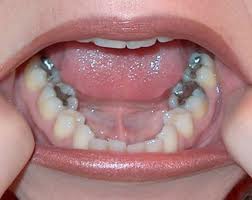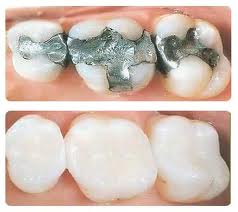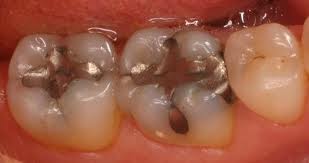This article discusses what fillings are before moving on to explain the different alternatives there are available to traditional silver amalgam.
What are Dental Fillings?

Fillings are restorations used by dentists to repair minor damage and cavities in dental enamel. Once the dentist has ensured that there is no sign of infection or decay – or once all infection and decay has been successfully removed and/or treated – a filling material is applied to the surface of the tooth. This is subsequently cemented in place using the heat generated by a special dentist’s hand-held light.
There are many different kinds of filling materials. Traditionally, dentists have always used silver amalgam or gold to repair light damage to the tooth structure, especially on the biting surfaces of the molars and pre-molars. This is because silver amalgam and gold are exceptionally strong and won’t fracture under the intense chewing and grinding stresses that are found there. However, few patients are amenable to the idea of having their visible front teeth covered with silver! Few people, if any, can pull off a metallic smile!
Thankfully, many advances in dentistry in Chicago have seen the development of dental filling materials that are both durable and can convincingly mimic the color and appearance of natural dental enamel.
Alternatives to Silver Amalgam Dental Fillings

Chicago Dental Info: Composite Fillings are natural tooth-colored fillings composed of a blend of glass-like particles and acrylic resin. They’re durable, resistant to wear-and-tear and require less natural tooth structure to be removed during preparation than amalgam. Composite dental fillings do, however, take longer to place.
Chicago Dental Info: Ionomers are tooth-colored fillings composed of a mixture of fine glass powder and acrylic acids. They are recommended for cavities that occur near the roots of the teeth or between the teeth, where the chewing forces are small. Owing to their construction from glassy materials, ionomers are highly aesthetic, but have a low fracture resistance, which is why they’re only applied to the tooth surfaces that receive little stress.
Chicago Dental Info: Ceramic Fillings: These dental restorations composed of porcelain or ceramic include veneers, crowns, inlays and onlays. This material is most popular for its ability to mimic the optical properties of natural dental enamel. Ceramics are also very strong and durable, but can fracture when subjected to impact or extreme tension.
Dispelling the Myth about Amalgam Dental Fillings

Many patients are worried about the health implications of amalgam dental fillings because, amongst a mixture of other metals, they contain a tiny amount of mercury. The inclusion of mercury in the alloy is necessary to make the material pliable.
While mercury is known to be toxic, there is no scientific evidence indicating amalgam fillings to be harmful to patients in any way. This is after much investigation by the Food and Drug Administration (FDA) and other Chicago Dental institutes. Amalgam has been used by dentists for over 100 years to fill flaws and cavities in teeth and after the extensive investigations performed by the FDA, no reason has been found to limit its use. The only exception to this would be patients that are allergic to this restorative material, although cases of this are rare.
No comments:
Post a Comment